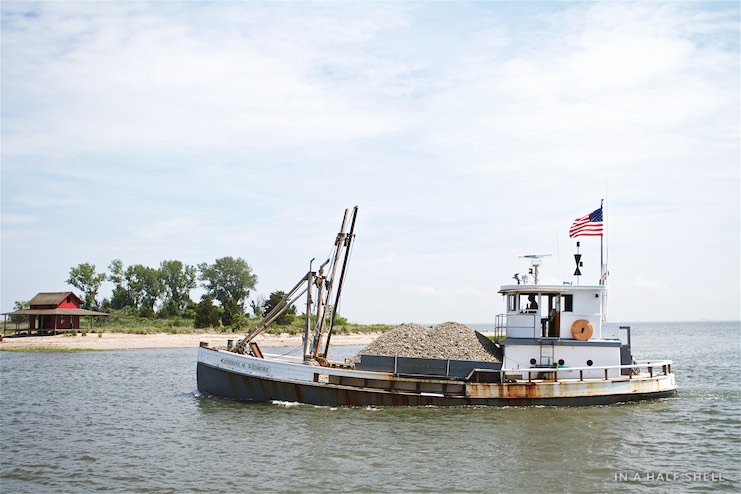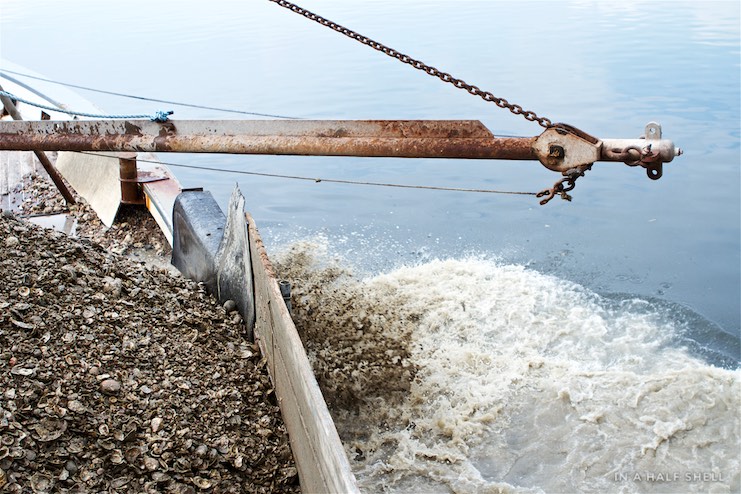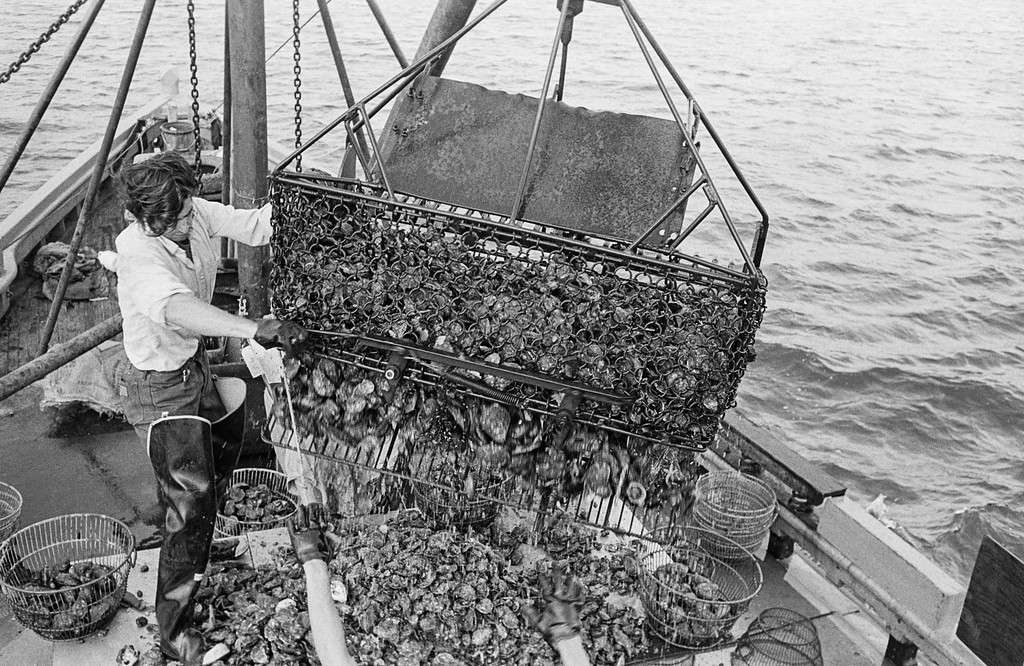Bluepoint Oysters: Then and Now
The Blue Point Oyster, or Bluepoint for short, is an iconic American oyster. Trying your first Bluepoint is like trying on your first pair of jeans. It's classic, timeless, and (for better or worse) commonplace.
Bluepoints weren't that special to me, and for a long time, I have written and talked about them as such. It wasn't until fairly recently—from a very cool field trip last July and a serendipitous meeting yesterday—that I started to look at the humble Bluepoint a little bit differently.
Bluepoints? Mmmeh.
For years, when people asked for my opinion about the Bluepoint, I'd offer a tepid response. I conscientiously acknowledged its widespread popularity, prevalence, and affordable price (btw: if you're buying Bluepoints in NYC at the raw bar for more than $2.75 a piece, you're overpaying). But today, "Bluepoints" have become a generic name used to sell any Virginica oyster from the Long Island Sound in the New York and Connecticut harvest regions, or from as far away as New Jersey, Maryland, and Virginia (nonsensical, but true). As a result, there is a great deal of variability in the quality and taste. The "genuine Blue Point Oyster" was all but lost in time.. or at least, that's what I had read and been told in my early oyster exploration days.
"You will see Bluepoints on every oyster menu in Manhattan, and quite a few elsewhere, because many people believe they want Bluepoints and nothing but. The oysters themselves are seeded on the bottom of Long Island Sound, both the Oyster Bay area of Long Island and the Norwalk area of Connecticut, dredged up a few years later, and have an extremely mild taste. You can do better." — Rowan Jacobsen, A Geography of Oysters
I guess my lack of enthusiasm for Bluepoints stemmed from the perception that they're literally everywhere, and yet, from nowhere at the same time. Let's be real here. It's not that fun to eat naked, anonymous oysters. I'm very glad to say that there is more to the story of the Bluepoint than what is commonly told... because while there may not be a specific "somewhere," there is a someone.
8 out of 10 Bluepoints Come From Here
There are several companies who produce and market "Bluepoint" oysters, but one dominates the game. Enter Norm Bloom & Son, arguably the largest oyster producer of the Northeast, claiming that they supply 8 out of 10 Bluepoints on the market. They helped popularize the Bluepoint in its early days. This three-generation family business has been working the Connecticut waters since the 1940's and have mastered growing oysters at scale. The image above isn't of live oysters, but rather, old oyster (and clam and mussel) shells that are being prepped for shelling. Roughly 150-170 thousand bushels* of shells are collected for this vital part of the process. Using JP (see top image, bottom right) as a reference point... he's about 6 feet tall... I estimated that this man-made midden is roughly 20 feet high and roughly 100 feet long. And this is just one of many. What's the deal with shelling? I will talk more about this later.
My first point of contact with this rather discrete and recluse company was through Jean Paul (aka JP) Vellotti, Bloom & Son's former sales & marketing director, professional photographer, and oyster enthusiast. Random story: in 2012 and unbeknownst to either of us at the time, I pledged support for JP's Kickstarter project that would attempt to upcycle one of our country's oldest working oyster boats (built in 1891), the Laurel, which once was a part of the Bloom fleet. Sadly the project never got fully funded, but some pieces of the Laurel will continue to live on in a form that will be officially made available next month! See teaser here. And here.
Now fast forward to one year ago. I got an email—excerpt pasted below—from JP inviting me out to learn more about Copps Island Oysters from Norm Bloom & Son. After some scheduling back and forth, we nailed down a date in early July when the crew would be shelling the oyster beds.
It might be a good chance to compare/contrast how traditional oyster growers like ourselves differ from seasonal aquaculture farms. For one thing, we are the only remaining "traditional" farm in the Northeast. Our bottom planted oysters start life as wild set which attaches to the dry shell we spread out during the summer. From there, it's a three to four year period of natural cultivation until it reaches market size.
Copps Island Oysters vs Blue Point Oysters
Simply put, Bluepoints are a commodity** and Copps Island Oysters is a trademarked brand. The oyster is more or less the same, but at least with a Copp Island, you know that it's coming from Bloom. With that, there is a certain level of consistency, quality control, and prestige. Copps Islands have been on the market for over two years now and I have seen them in place of "Bluepoints" now around 25% of the time in NYC. This move towards a "branded oyster" is one that many oyster growers and chefs have chosen to adopt over the last several years, but it isn't without controversy. We're probably living in an oyster brand bubble right now and I wouldn't be surprised to see "peak oyster marketing" in the near future. But I'll be the first to admit that a good name and storytelling does somehow influence my irrational sense of decision making. To take a page from the Most Interesting Man in the World: "I don't always eat Bluepoints, but when I do, I prefer Copps Islands." And this IS irrational because even if I just ordered some regular old Bluepoints, chances are that they would be from Bloom as well.
Shelling the Great Connecticut Oyster Beds
On an early July morning, I took the Metro North up to New Haven, CT. I felt pretty relaxed, but JP was more anxious. The crew had been shelling the oyster beds since 6AM and he was concerned that I'd have nothing to see by the time we got there. JP picked me up in his behemoth tan Toyota FJ Cruiser, which resembled a tank more than a truck. As we drove west to a location where he knew that one of the shelling boat would pass by, JP schooled me on some oyster history.
This would be the first time that I'd really learn about the "traditional bottom planting" method. While I won't get into the differences between extensive and intensive aquaculture here, you can learn more about it in my Louisiana oyster post. This old school way of oyster farming has been the way of life for many families and communities up and down the Atlantic coastline—most notably in Long Island Sound, the Chesapeake Bay, and the Gulf of Mexico.
We reached a scenic landing in Guilford, CT where the vista was as vast and flat as the serene wetlands of the Eastern Shore. We waited for a minute and then JP pointed out to the horizon of the open sea. "She's on her way here," my eagle-eyed friend announced. I had to squint super hard to spot the boat that he was talking about. Within minutes, the Catherine Wedmore (all of the boats had elegant names like that) passed by us, hauling a substantial pile of shell.
Catherine Wedmore proceeded to unload the shells gradually into the water near where we were observing from, and then slipped away as quietly as she had arrived. Shelling the oyster beds is an annual routine that is akin to tilling the soil before planting the crops. At the time of shelling, the wild oysters in the area have already fully released their spawn into the water. So after awhile, the free swimming oyster larvae will settle down onto whatever they find at the bottom — and hopefully, that would be a shell or some other viable substrate. Easy right? Not quite. There's the problem of when and where.
When? The timing of the spawning varies year by year, which the decision of when to lay the shell down a never-ending puzzle. Laying down the shell substrate too early or too late could cost hundreds of thousands of dollars-worth of product later on. So the crew must remain vigilant and jump on the right opportunity at full throttle.
Where? You also never know exactly where the water current might usher the larvae to, so the more acres of land you have to work with, the better. Fortunately, Norm Bloom & Son has plenty of that. Some of the land (or underwater acreage, I suppose in this case) that the Bloom family has exclusive leases to to are incredibly old — even older than the United States itself! The titles been passed down through generations and originated as the King's grants.
When you don't have such advantages of time and space, or a strong enough of a wild oyster spawn, growers must then rely on oyster hatcheries for their seed.
Once the oyster larvae settle onto the shells and take some time to eat and grow bigger, the whole lot is dredged up and transported to other grow out sites. Oyster nurseries might be healthy, safe places for juveniles to grow, but in order to get the best shapes and yield, they'll need to be spaced out eventually. JP noted that most of these oysters will take at least three or four years to reach market size. Managing the shelling, dredging, culling, and replanting — all executed with a large fleet of boats — is a ton of work and logistics. It's enough to make my head spin!
This was an especially busy time for the crew, but Jimmy Bloom, oyster boat captain and Norm Bloom's son took some time to say hello. Since the age of six, Jimmy has been groomed to take over the family business. His father instilled a sense of entrepreneurship and stewardship in his son early on by giving him a piece of land to plant his own oysters on. Today, Jimmy basically runs the show and is responsible for millions of oysters in the water. That's pretty bad ass.
And you know what else is bad ass? We made it to the loading dock just in time to hop aboard the S.W. Sheppard with Captain Lou and his crewmate Julio to get a first-hand look at just how "releasing the shells" is done. I climbed up a flight of stairs to the captain's room and saw that the enormous pile of recycled shells stopped just short of obstructing the view. We left the dock and glided down the Quinnipiac River towards the Grand Avenue Swing Bridge, which gracefully swung open for allow us safe passage.
After we had reached the proper "drop off" point, Captain Lou gave the go ahead to Julio to start offloading the goods. He took hold of a Kelly green hose and turned on the water. Bits and pieces of shell went flying. The scene and sounds were really quite something to behold. Thousands of oyster shells were hosed down along the starboard side of the boat and then spewed into the river through a slim gateway. The photos really don't do it justice, so here's a quick Instagram video of the action as well. Once the boat was washed clean, the S.W. Sheppard turned around and headed back to the dock for the next load.
On Scale and Sustainability
Although the Bluepoint has become a staple of our oyster-loving society, are they sustainable? Coming out of the recent Chefs Collaborative Sustainable Food Summit in New York City, my sensitivity towards the damaging effects of industrial agriculture is sharper than ever. In a world that seems to be reverting to "artisanal," and "small," does this form of oyster farming belong in the past or part of the future?
Extensive aquaculture has been in existence since the late 19th century, and my hope is that it will continue to play a key role in our domestic seafood production. From my time here and in Gulf, as well as the six months that I've spent working at Australis Aquaculture (a leader of responsible fish farming, which is completely different from oyster farming, but there are still shared themes), I've come to appreciate an underrated insight in today's food business: big doesn't necessarily mean bad, and small doesn't guarantee justice for all.
If we expect real, positive, scalable change to happen within our food system, we must evaluate "sustainable practices" with the same breadth and depth as we critique many "unsustainable practices." To quote Barton Seaver, "Sustainability cannot be defined by the absence of negative impacts." I think that industrial scale oyster farming produces a far more efficient and nutritious source of protein than other land-based animal farms and also provides meaningful jobs to hundreds (directly and indirectly). Additionally, it is making good, honest use of our coastline to supply our country with delicious, domestically produced seafood. I believe that oyster businesses, like Norm Bloom & Son, does more good than harm. And in some cases, they try to do even better — Taylor Shellfish Farms recently announced that they are the first farm in the US to receive ASC Certification.
Coincidentally, Norm Bloom & Son has an interesting connection to Taylor Shellfish Farms... and it is what really sparked me to finally write this post.
A Glimpse Into the Past
On the last day of the Chefs Collaborative Summit, I was introduced to "Oyster Bill" Whitbeck, Seattle-based Restaurant Sales Manager for Taylor Shellfish Farms. Naturally, an oyster-packed conversation ensued.
It turns out that Bill is originally from Norwalk, CT and his family were close friends of The Blooms. After graduating Kent State University for photojournalism, he decided to open up a photography studio in the old Radel Oyster Company building in South Norwalk with the help of the Bloom brothers.
"While having the studio, I photographed all of the aspects of oystering in and around the Norwalk Islands, and as far as I know, I was the only photographer who documented this during that time period of the 1970’s and 80’s. I’ve kept all these original negatives for over 40 years, and have just recently begun scanning them, producing high resolution digital files of these very wonderful images!" — Bill Whitbeck
That's when Bill took out his iPhone and showed me a series of this breathtaking black and white photos below. They are photographs of the Bloom oyster operations from the late 70's, and I was surprised to see just how much of it has remained unchanged.
To see loads more from this collection, check out Bill's SmugMug account, "Looking Back."
Photo by Bill Whitbeck
Photo by Bill Whitbeck
Photo by Bill Whitbeck
Photo by Bill Whitbeck
Photo by Bill Whitbeck
Photo by Bill Whitbeck
Photo by Bill Whitbeck
Photo by Bill Whitbeck
All photos in this section are taken by, and are the property of Bill Whitbeck. Please ask for permission from the photographer before republishing.
Gratitude
This story was made possible by the hospitality of Bloom family and crew, and I would like to call out a special thanks to JP Vellotti for his hard work in organizing this trip. Also, thanks to Bill Whitbeck for allowing me to republish some of his amazing photographs (that haven't been seen in 40 years), which acted as the final spark to get this thing posted in a way that I am beyond thrilled with.
*Fun fact: A "true honest bushel" comprised of 400 oysters back in the today. Today, it's generally accepted to be 200. What??
**Clarification:There once was such a thing as a "genuine" Bluepoint, and Blue Island Shellfish (see comments below) has made attempts to bring back the Genuine Blue Point Oyster, but the marketplace today doesn't call out this distinction... nor really care (at least that's what I've observed.)



























